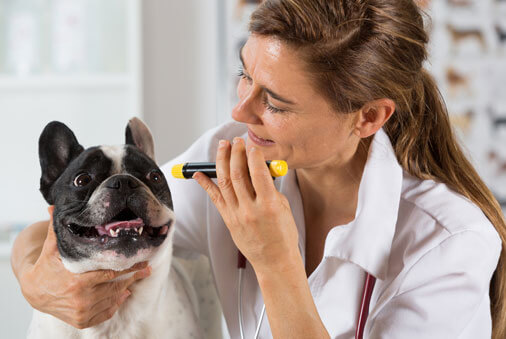Most of the time the infection involves their outer ear canal and is called canine otitis externa. Because canine ear canals are vertical, unlike our horizontal ear canals, they collect more debris than human ears.
Floppy-eared dogs, canines who are avid swimmers, recently vaccinated pups, senior dogs, and those with allergies, thyroid imbalances, or immune system disorders tend to have more ear infections than other canines. Bacteria, yeast, ear mites, excessive hair, moisture, wax, or foreign bodies can get trapped in their canals.
Infections in the middle and inner ear are more serious but usually start with external ear infections. If your dog is tilting his head a lot, circling or seems uncoordinated, see your veterinarian right away. Early diagnosis can prevent further infection, which is important for eardrum and overall hearing health.
Other ear infection symptoms include: head shaking, pawing at ears, whining, dark and odorous discharge, scaly skin, redness, swelling and/or itchiness of the ears. Strong odor is a telltale sign, since healthy ears seldom smell bad.
Your veterinarian will prescribe topical medications or systemic antibiotics coupled with painkillers such as Tramadol, and/or a steroid to help reduce inflammation.
Tips to prevent ear infections:
- Use cotton balls in your dog’s ears to prevent moisture from seeping in. Doggie snoods or hoods can work like bathing caps to protect from stray water if your dog tolerates wearing one.
- Dry your dog’s ears with cotton balls after he swims.
- No D.I.Y. cleaning if you suspect an ear infection. Only clean your dog’s ears when he’s healthy, according to a schedule recommended by your veterinarian.
- Gently remove visible debris from your dog’s outer ear canal.
- Prepare a cup of witch hazel or an equal mix of organic apple cider vinegar and purified water. Squirt or pour some of the solution into the outer portion of your dog’s ear. Never use a syringe to push liquid directly into his inner ear. Instead, holding your dog’s ear closed, gently massage the liquid into his ear.
- Your dog will likely shake his head, which helps absorb the solution. Use gauze to gently wipe the canal from the inside out; avoid paper or cotton towels that leave fibers behind. Cotton swabs may be used to clean the outer folds, just avoid poking them into your dog’s ear.
- Trim the hair inside and around your canine’s ear canal, an easy task for a professional dog groomer.
- Smell around your dog’s ears to sniff out any infection. Remember, healthy ears don’t smell funky.
Dogs have far better hearing capabilities than humans. By helping to keep your canine’s ears healthy, he’ll continue to beat you at a hearing contest any day of the week.





